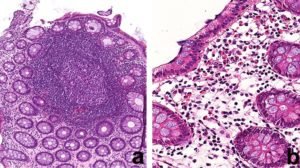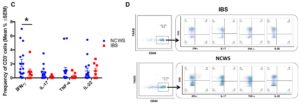closed
Antonio Carroccio,University of Palermo, Italy
3-years Project
Gluten Sensitivity
Area: Clinical Trial
- Grant: FC 013/2014
- Title: Wheath-sensitivity evaluated by double-blind placebo-controlled method: risk for malnutrition osteoporosis and associated autoimmune diseases
- Topic: Gluten Sensitivity, Clinical Trial
- Duration: Triennial Project
- Principal Investigator: Antonio Carroccio, Unversity of Palermo
Publications originated from the Project:
- Carroccio A, Soresi M, D’Alcamo A, et al. Risk of low bone mineral density and low body mass index in patients with non-celiac wheat-sensitivity: a prospective observation study. BMC Med 2014; 12: 230 https://pubmed.ncbi.nlm.nih.gov/25430806/
- Carroccio A, D’Alcamo A, Cavataio F, et al. High Proportions of People With Nonceliac Wheat Sensitivity Have Autoimmune Disease or Antinuclear Antibodies. Gastroenterology 2015; 149: 596-603 https://pubmed.ncbi.nlm.nih.gov/26026392/
- Di Liberto D, Mansueto P, D’Alcamo A, et al. Predominance of Type 1 Innate Lymphoid Cells in the Rectal Mucosa of Patients With Non-Celiac Wheat Sensitivity: Reversal After a Wheat-Free Diet. Clin Transl Gastroenterol 2016; 7: e178 https://pubmed.ncbi.nlm.nih.gov/27388423/
- D’Alcamo A, Mansueto P, Soresi M, et al. Contact Dermatitis Due to Nickel Allergy in Patients Suffering from Non-Celiac Wheat Sensitivity. Nutrients 2017; 9: 103 https://pubmed.ncbi.nlm.nih.gov/28157173/
- Carroccio A, D’Alcamo A, Iacono G, et al. Persistence of Nonceliac Wheat Sensitivity, Based on Long-term Follow-up. Gastroenterology 2017; 153: 56-58 https://pubmed.ncbi.nlm.nih.gov/28365444/
- Carroccio A, Giambalvo O, Blasca F, Iacobucci R, D’Alcamo A, Mansueto P. Self-Reported Non-Celiac Wheat Sensitivity in High School Students: Demographic and Clinical Characteristics. Nutrients 2017; 9: 771 https://pubmed.ncbi.nlm.nih.gov/28753927/
- Soresi M, Mansueto P, Terranova A, et al. Abdominal Ultrasound Does Not Reveal Significant Alterations in Patients With Nonceliac Wheat Sensitivity. J Clin Gastroenterol 2019; 53: e31-e36 https://pubmed.ncbi.nlm.nih.gov/29206754/
- Carroccio A, Giannone G, Mansueto P, et al. Duodenal and Rectal Mucosa Inflammation in Patients With Non-celiac Wheat Sensitivity. Clin Gastroenterol Hepatol 2019; 17: 682-690 https://pubmed.ncbi.nlm.nih.gov/30138736/
Project rationale and aims
Although Non-Celiac Wheat Sensitivity (NCWS) is could be considered close to the Celiac Disease (CD), up to date, there are no data about the existence of associated risk, as malnutrition, osteoporosis, oral mucosa manifestations, autoimmune diseases, which on the contrary are well known in CD patients. Furthermore, no biomarkers, neither serological nor mucosal, are nowadays known to pose NCWS diagnosis. Aims of the present projects are: 1) to evaluate the existence and the frequency of osteopenia and osteoporosis in patients with Irritable Bowel Syndrome (IBS)-like symptoms, at the time of NCWS diagnosis and during the 3-years follow-up period; 2) to evaluate the existence and the frequency of autoimmune diseases and autoantibodies in the same patients, at the time of NCWS diagnosis and during the 3-years follow-up period; 3) to evaluate the existence and the frequency of oral mucosa lesions in patients with IBS-like symptoms, at the time of NCWS diagnosis and during the 3- years follow-up period; 4) to evaluate the existence and the frequency of malnutrition in patients with IBS-like symptoms, at the time of NCWS diagnosis and during the 3-years follow-up period; 5) to search for possible immunological makers of NCWS by studying the intestinal mucosa histology and cytokines patterns. This could help in understanding the pathogenetic mechanisms.
Research plan and results obtained
Task 1. Collection, characterization by Double-Blind Placebo-Controlled (DBPC) wheat challenge and analysis of a suitable number of NCWS patients and controls (CD and IBS). Among the patients with suspected NCWS and IBS-like clinical presentation, referred at the Internal Medicine and at the Gastroenterology Units of the University of Palermo, during the six years of the project, 242 accepted to entry in the study and underwent the elimination diet (with the exclusion of wheat and cow’s milk and derivatives), and the successive DBPC challenge. Of these 242 patients, 96 (39.7%) were diagnosed as suffering from NCWS. Sex- age matched CD and IBS controls were also recruited.
Task 2. Histology and Cytokines studies. Duodenal and colon mucosa biopsies, followed by histology and cytokines studies, also on Peripheral Blood Mononuclear Cell (PBMC), were performed.
Task 3. Nutritional status assessment. Body Mass Index (BMI), measurement of tricipital skinfold together with arm circumference, biometric impedance analysis, and biochemical parameters in NCWS patients were evaluated.
Task 4. Dietary and lifestyle assessment. The health and lifestyle questionnaire, considering menarche and age at menopause if applicable, medical and drug abuse history, lifestyle habits was recorded at the patients’ recruitment.
Task 5. Bone mineral density assessment. Selected NCWS patients underwent Bone Mineral Density (BMD) assessment by Dual Energy X-Ray Absorptiometry (DEXA), duodenal histology, HLA DQ typing, BMI evaluation and assessment for daily calcium intake.
Task 6. Assessment of associated autoimmune diseases. We collected data about this aspect (i.e. a questionnaire to identify those with autoimmune disease, and measurement of non-organ and organ-specific autoantibodies).
Task 7. Assessment of oral soft and hard tissue lesions. All patients underwent oral examination to assess the presence or not of oral soft and hard tissue lesions potentially associated to NCWS and CD.
Experimental design and methodologies
NCWS diagnosis were posed according to the criteria recently proposed. In brief, the patients met all the following inclusion criteria: a) negative serum anti-transglutaminase (anti-tTG) and anti-endomysium (EMA) IgA antibodies b) negative duodenal histology (absence of intestinal villous atrophy); c) negative IgE-mediated immuno-allergy tests to wheat (skin prick tests and serum specific IgE detection, i.e. RASTs). At entry to the study, those patients who had self-reduced wheat consumption were invited to assume a minimum quantity of 100 g of wheat daily and were observed for 2-4 weeks on a regular diet. All patients then commenced a standard elimination diet, based on our previous experience, with the exclusion of wheat, cow’s milk, eggs, tomato, and chocolate. After 4 weeks on elimination diet, they underwent DBPC challenges, with wheat flour or rice flour (80 grams) in sacks coded A or B respectively.
Potential pitfalls and caveats
We have not particular concerns, referring to the work planned, during the course of the entire project.
Conclusions and discussion
We were able to recruit a number of patients higher than that calculated for this project. Furthermore, we are glad to can contribute to clarify some aspects of NCWS, answering to some questions which we posed to ourselves at the beginning of the study. NCWS is probably a melting pot, with different patients lumped together under a common label. The data of this projects, however, permit to find some common aspects between NCWS and CD: 1) similar associated risks (autoimmunity and osteoporosis), 2) similar long-life condition in a majority of NCWS patients. However, clear differences must be underlined: no strict need for a wheat-free diet, and probably other gluten-containing cereals, and some ancient wheat species can be tolerated by NCWS patients. However, whether a wheat-free diet could prevent the above mentioned risks remains to demonstrate. The search for a biomarker of NCWS is captivating. We showed that both the duodenal and rectal mucosa are inflamed in NCWS patients and that eosinophils are higher in number here than in patients who referred the same symptoms but did not respond to the wheat challenge. We demonstrated that the rectal mucosa in NCWS patients frequently showed lymphoid follicles, and overall that the eosinophil density in the lamina propria was significantly higher in NCWS patients than in controls (see Figure 1).
Consequently, NCWS could be considered an inflammatory condition of the entire intestinal tract and the eosinophil infiltration a key candidate marker and player in the pathogenesis of NCWS.
Furthermore, we showed that in patients with active NCWS, IFN-g-producing ILC1 cells infiltrate rectal mucosa (Figure 2)

and this datum supported a role for this innate lymphoid cells population in the pathogenesis of NCWS.
On the whole, our studies highlighted that the pathogenesis of NCWS, at least in a percentage of these patients, have an immunologic basis.
